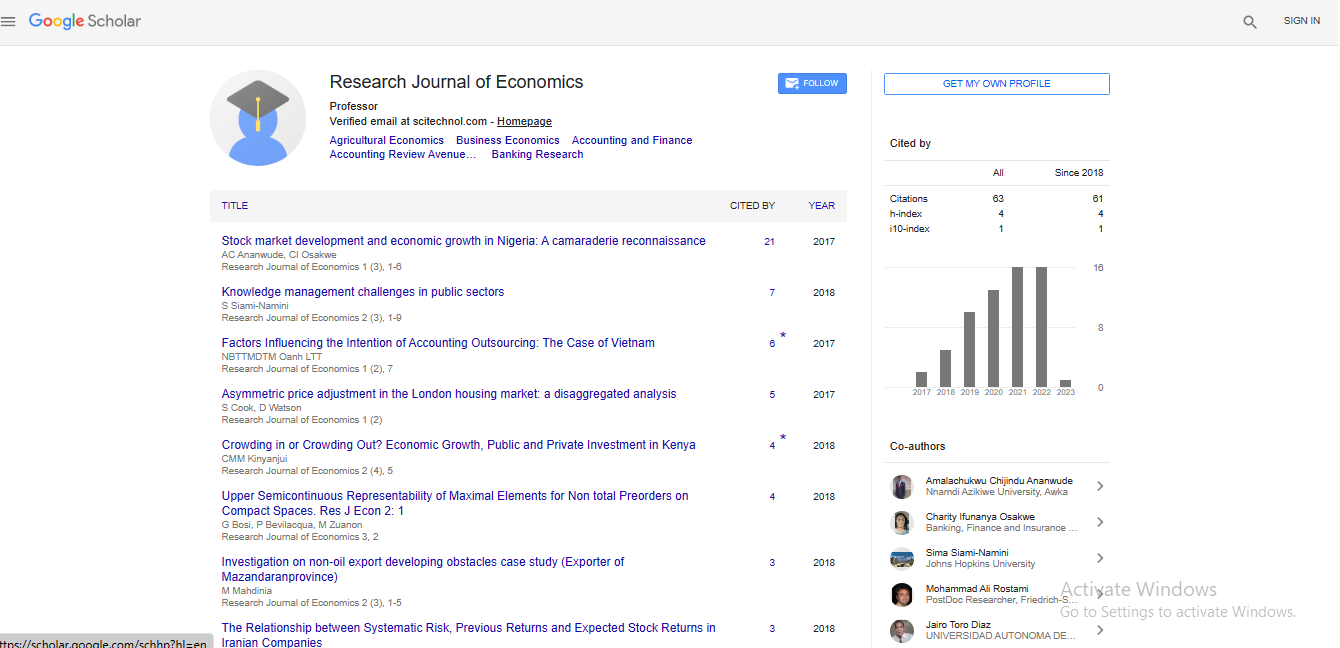Commentary, Res J Econ Vol: 8 Issue: 1
Market Capitalization: Estimates for Future Prospects
Senityr Wilan*
Department of Applied Economics, University of Castilla La Mancha, Ciudad Real, Spain
- *Corresponding Author:
- Senityr Wilan
Department of Applied Economics,
University of Castilla La Mancha,
Ciudad Real,
Spain;
E-mail: senityr_wilan @gmail.com
Received date: 04 November, 2023, Manuscript No. RJE-23-119236;
Editor assigned date: 06 November, 2023, PreQC No. RJE-23-119236 (PQ);
Reviewed date: 20 November, 2023, QC No. RJE-23-119236;
Revised date: 15 July, 2024, Manuscript No. RJE-23-119236 (R);
Published date: 22 July, 2024, DOI: 10.4172/RJE.1000176
Citation: Wilan S (2024) Market Capitalization: Estimates for Future Prospects. Res J Econ 8:1.
Description
It is computed by multiplying a stock's price by the number of outstanding shares. The significance of market capitalization It enables investors to comprehend the size of one firm in comparison to another. Market capitalization represents a company's open market value as well as the market's estimate of its future prospects, since it reflects what investors are prepared to pay for its stock.
The value of a firm is a vital duty that is sometimes difficult to determine quickly and effectively. Simply multiply the share price by the number of available shares in this scenario. After a firm goes public and begins trading on the exchange, the price of its shares in the market is decided by supply and demand. If its shares are in strong demand owing to positive conditions, the price will rise. If the company's future growth prospects do not appear promising, sellers of the stock may push down its price. The market capitalization is then a real-time assessment of understanding.
Companies were formerly classified as large-cap, mid-cap, or small-cap. The phrases mega-cap and micro-cap have now gained currency, while nano-cap is occasionally encountered. Different indexes utilize different numbers there is no definitive definition of, or complete agreement on, the exact cut off values. Cut offs might be expressed as percentiles rather than in dollars. Because of inflation, population growth, and general market value (for example, $1 billion was a huge market cap in 1950, but it is not particularly large now), definitions defined in nominal dollars must be changed over decades, and market caps are likely to differ by nation.
Market capitalization is a common approach of appraising businesses. It provides a consistent method for determining the size and value of publicly listed corporations. Investors may immediately comprehend the comparable worth of a firm in contrast to others in the market by evaluating market cap. This global strategy simplifies investment analysis and facilitates in the evaluation of prospects in many businesses and areas.
Market capitalization provides reliable estimates of a company's size and attributes. Large market capitalization companies often have established operations, a significant market share, and enormous resources. Smaller market cap firms, on the other hand, may represent fledgling enterprises with significant growth potential but considerable risk. The exact recommendation provided by market cap assists investors in aligning their investing strategy with their risk tolerance and financial goals.
The content and weightage of market indexes are heavily influenced by market capitalization. The bigger the company's market capitalization, the greater its influence on the index's performance. As a result, changes in the market capitalization of prominent corporations can have a major influence on the overall performance and direction of market indexes. It is crucial to understand that a company's market capitalization represents just the sum of its equity values. The whole worth of a firm, including debt and equity capital, is its enterprise value.
A house provides a straightforward illustration of the distinction between business value and equity value. The equity value of a property with a $1,000,000 appraisal and a $700,000 mortgage is $300,000. This also holds true for businesses. An enterprise value of $15 billion is assigned to a corporation having a market capitalization (equity value) of $10 billion and debt of $5 billion.
 Spanish
Spanish  Chinese
Chinese  Russian
Russian  German
German  French
French  Japanese
Japanese  Portuguese
Portuguese  Hindi
Hindi 